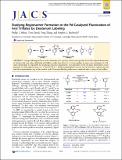| dc.contributor.author | Milner, Phillip John | |
| dc.contributor.author | Kinzel, Tom | |
| dc.contributor.author | Zhang, Yong | |
| dc.contributor.author | Buchwald, Stephen Leffler | |
| dc.date.accessioned | 2015-11-02T18:49:21Z | |
| dc.date.available | 2015-11-02T18:49:21Z | |
| dc.date.issued | 2014-10 | |
| dc.date.submitted | 2014-09 | |
| dc.identifier.issn | 0002-7863 | |
| dc.identifier.issn | 1520-5126 | |
| dc.identifier.uri | http://hdl.handle.net/1721.1/99657 | |
| dc.description.abstract | Isotopic labeling has been used to determine that a portion of the desired product in the Pd-catalyzed fluorination of electron-rich, non-ortho-substituted aryl triflates results from direct C–F cross-coupling. In some cases, formation of a Pd-aryne intermediate is responsible for producing undesired regioisomers. The generation of the Pd-aryne intermediate occurs primarily via ortho-deprotonation of a L·Pd(Ar)OTf (L = biaryl monophosphine) species by CsF and thus competes directly with the transmetalation step of the catalytic cycle. Deuterium labeling studies were conducted with a variety of aryl triflates. | en_US |
| dc.description.sponsorship | National Institutes of Health (U.S.) (Award GM46059) | en_US |
| dc.description.sponsorship | National Science Foundation (U.S.) (Predoctoral Fellowship 2010094243) | en_US |
| dc.description.sponsorship | Amgen Inc. | en_US |
| dc.description.sponsorship | Alexander von Humboldt-Stiftung (Feodor Lynen Postdoctoral Fellowship) | en_US |
| dc.language.iso | en_US | |
| dc.publisher | American Chemical Society (ACS) | en_US |
| dc.relation.isversionof | http://dx.doi.org/10.1021/ja509144r | en_US |
| dc.rights | Article is made available in accordance with the publisher's policy and may be subject to US copyright law. Please refer to the publisher's site for terms of use. | en_US |
| dc.source | ACS | en_US |
| dc.title | Studying Regioisomer Formation in the Pd-Catalyzed Fluorination of Aryl Triflates by Deuterium Labeling | en_US |
| dc.type | Article | en_US |
| dc.identifier.citation | Milner, Phillip J., Tom Kinzel, Yong Zhang, and Stephen L. Buchwald. “Studying Regioisomer Formation in the Pd-Catalyzed Fluorination of Aryl Triflates by Deuterium Labeling.” Journal of the American Chemical Society 136, no. 44 (November 5, 2014): 15757–15766. © 2014 American Chemical Society | en_US |
| dc.contributor.department | Massachusetts Institute of Technology. Department of Chemistry | en_US |
| dc.contributor.mitauthor | Milner, Phillip John | en_US |
| dc.contributor.mitauthor | Kinzel, Tom | en_US |
| dc.contributor.mitauthor | Zhang, Yong | en_US |
| dc.contributor.mitauthor | Buchwald, Stephen Leffler | en_US |
| dc.relation.journal | Journal of the American Chemical Society | en_US |
| dc.eprint.version | Final published version | en_US |
| dc.type.uri | http://purl.org/eprint/type/JournalArticle | en_US |
| eprint.status | http://purl.org/eprint/status/PeerReviewed | en_US |
| dspace.orderedauthors | Milner, Phillip J.; Kinzel, Tom; Zhang, Yong; Buchwald, Stephen L. | en_US |
| dc.identifier.orcid | https://orcid.org/0000-0003-3875-4775 | |
| dspace.mitauthor.error | true | |
| mit.license | PUBLISHER_POLICY | en_US |
| mit.metadata.status | Complete | |
